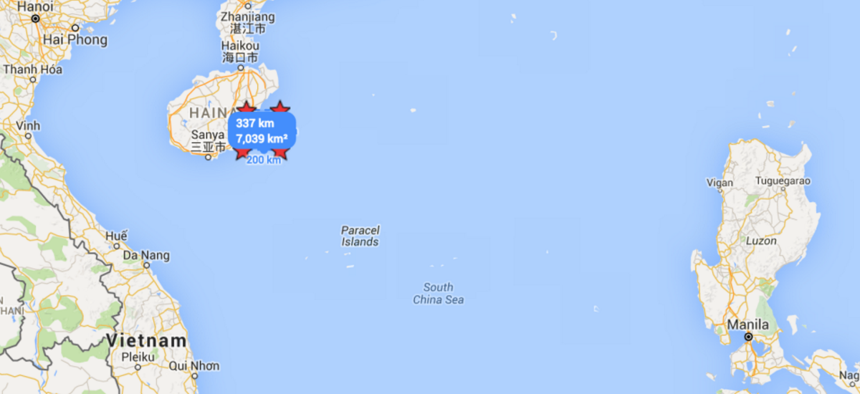
The area China cordoned off for military drills running July 19-21. Quartz
Beijing Announces New Plans to Break International Law in South China Sea
During a three-day visit from the U.S.'s top admiral, China flouts UN ruling on contested waters.
China appears to have timed military activities in the South China Sea to take place in the days both before and after a ruling that largely invalidated its sweeping claims to the strategic waterway.
The country’s maritime safety agency announced today (July 18) that military exercises will be held in an area of the sea southeast of China’s Hainan Island, from tomorrow through Thursday.
The short announcement included the dates of the drill, the geographic coordinates of the area, and the terse warning: “Entering prohibited.”
China made a similar announcement earlier this month when it cordoned off a larger area of the sea for drills that included live-fire war games and lasted from July 5 to July 11— ending one day before the ruling.
Chinese marine corps perform drill in South China Sea https://t.co/V9jUB3mTID pic.twitter.com/LbxASt7EaJ
— China SCIO (@chinascio) July 15, 2016
The problem with both drills is the “entering prohibited” part. China has every right to conduct military drills. But it doesn’t have a right to cordon off the high seas, even in its own exclusive economic zone (EEZ), as per the United Nations Convention on the Law of the Sea, the main treaty of international maritime law.
China signed the treaty in 1996, but Beijing’s response to the international tribunal’s ruling, and its military exercises in the area, suggest it has no intention of complying with it.
Beijing has also flexed its muscle in the air following the ruling. A few days after the ruling, it released photos of a nuclear-capable bomber flying over Scarborough Shoal (called Huangyan Island in China), which lies about 200 km (124 m) west of the Philippines’ Subic Bay.
And some photos brought by PLA Air Force: bomber H-6K fly over Huangyan Island pic.twitter.com/S2pMMsemf0
— China SCIO (@chinascio) July 15, 2016
The bomber flew over the Philippines’ EEZ—clearly, since all of Scarborough Shoal falls within that zone. Yet in China’s own coastal EEZ, the Chinese military routinely harasses foreign military aircraft (pdf, p. 17) operating there.
China’s aggressive takeover of the shoal in 2012 was a big reason for the arbitral proceedings, which the Philippines initiated in 2013, in the first place. Since then Filipino fishermen trying to operate in the area have been blocked or harassed—illegally, the tribunal ruled—by Chinese forces. They’re getting the same treatment following the ruling as they did before it.
Also after the ruling, China landed civilian aircraft on new airstrips at Subi Reef and Mischief Reef. The artificial island China built atop the latter came under particular fire from the tribunal, which said it generated no maritime entitlements and that its construction caused significant environmental damage.



